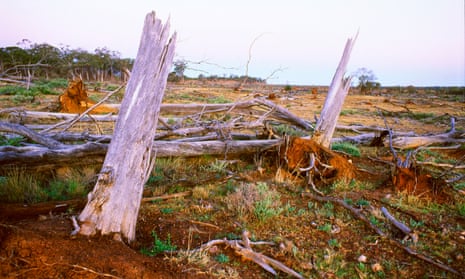More than 7.7m hectares of habitat have been cleared since the introduction of Australia’s national environment act, according to new research that finds 93% of land cleared was not referred to the federal government for assessment.
The study, led by researchers from the University of Queensland and three environment organisations – the Australian Conservation Foundation, WWF Australia and the Wilderness Society – warns that Australia’s high extinction rate will increase “without a fundamental change” in how environment laws are enforced.
The scientists used publicly available spatial data to quantify the amount of clearing of potential habitat for 1,638 listed threatened species and ecological communities – which are groups of species that form a single habitat – between 2000 and 2017.
They used the federal government referral record to calculate how much of the clearing had been referred to the government for assessment.
The study examined two types of habitat – forests and woodlands – and excluded clearing that had occurred before the Environment Protection and Biodiversity Conservation (EPBC) Act came into force in 2000 and any clearing that was due to natural causes such as fire.
They calculated that the land cleared included 7.7m hectares of potential habitat for terrestrial threatened species, 64,000 hectares of habitat for terrestrial migratory species, and 330,000 hectares for threatened ecological communities.
The researchers found that clearing had affected potential habitat for 84% (or 1,390) of the species studied and that the overwhelming majority of that clearing (93%) had not been referred to the federal government for scrutiny under the EPBC Act.
“This noncompliance means that potential habitat for terrestrial threatened species, terrestrial migratory species and threatened ecological communities have been lost without assessment, regulation or enforcement under the EPBC Act,” they wrote.
Some species suffered more habitat loss than others. According to the study, the Mount Cooper striped skink lost 25% of its potential habitat, the Keighery’s macarthuria, a plant native to Western Australia, lost 23% and the southern black-throated finch lost 10%.
The researchers found that 1.1m hectares of potential habitat for koalas had been cleared.

“These are the species threatened with extinction,” said Michelle Ward, the study’s lead author from the University of Queensland. “If we don’t stop their habitat loss, they’re going to go extinct.”
Queensland was the location of the highest levels of clearing – the state had nine of the 10 species that lost the most potential habitat.
A statutory review of the EPBC Act is due to begin this year. Ward said the researchers would be submitting comments based on their research.
Their paper says Australia’s national environment laws have been “ineffective” at preventing habitat loss and calls for amendments that require critical habitat, where possible, to be mapped and monitored for threatened species and ecological communities, and for protection of that habitat to be enforced.
“We think that the act should be amended so that critical habitat is mapped, available to stakeholders and fully protected from further destruction,” Ward said.
James Trezise, a policy analyst at the Australian Conservation Foundation and a co-author on the study, said the research highlighted how national laws had “systematically failed to protect threatened species and their habitats”.
“To potentially have more than 93% of threatened species habitat loss unregulated is completely unacceptable and demonstrates a massive compliance failure under the EPBC Act,” he said. “These findings should be a wake-up call to the federal government as it gears up to review the EPBC Act and as it enters negotiations for a new global framework for protecting nature through the UN.”
New post-2020 targets for nature are due to be established next year under the Convention on Biological Diversity.
Another co-author on the study, James Watson, of the University of Queensland and the Wildlife Conservation Society, said a review of the EPBC Act was essential.
“Australia is about to get a boot up the arse with the global post-2020 biodiversity agenda because the core part of that is stopping species extinction and Australia is doing dismally,” he said. “It’s globally embarrassing. The quicker we get a review and get it working, the better.”
